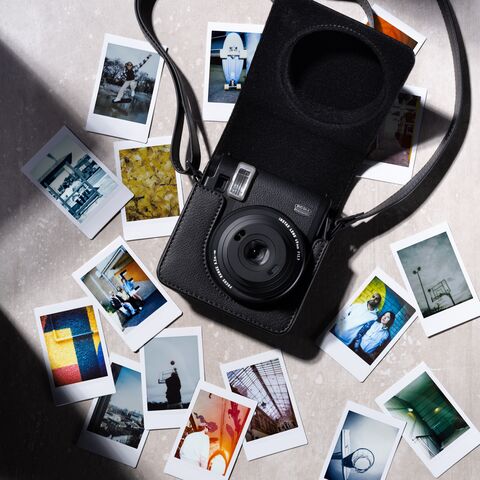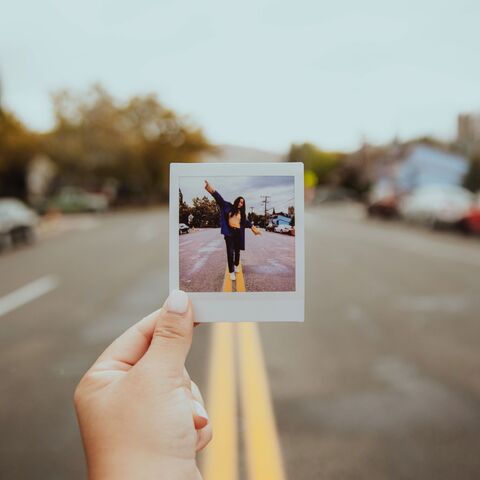Instant print cameras: The ultimate guide to capturing moments on the go
Instant print cameras are more popular than ever, and whether you’re an instant camera pro or this is your very first time snapping with one, we've got you covered with this guide looking at FAQs, tips, and tricks.
How do instant print cameras work?
Let’s start with the basics. The popular appeal of an instant print camera like the mini 41™ is that you can pose, press the shutter, and get a physical photo in your hand within minutes. It really is that simple. But what goes on inside your instant camera to make this happen?
When you snap a picture, the camera exposes the film to light. The film then passes through a set of rollers that evenly spread chemicals over it, starting the photo development process.
How long do instant photos take to develop?
The time it takes for instant photos to develop can vary depending on the type of film you're using.
If you’re lucky enough to have an instax camera, then it will take just 90 seconds to get your hands on the physical print.
Once your print is ready, you may have heard that shaking the photo will speed up the process (we'll talk more about this myth later!). Instead, let it develop in a stable environment away from direct sunlight for the best results.

How do you work an instant camera?
Using an instant print camera is a breeze, which is why they're perfect for capturing moments on the go.
- First, pop in the instax film pack, then power up the camera.
- Aim your shot or use the in-built selfie mirror feature if you’re snapping a pic of yourself.
- Press the shutter button, and voilà — your pic should start developing right away.
Within minutes, you’ve got a physical memory to share or keep. It’s like having a mini photo lab in the palm of your hand.
Do instant photos fade?
One of the most common questions we get about instant photos is how long they can last. They can fade over time, but proper care can keep them looking fresh for years.
Here are some top tips to preserve your instant prints:
- Always store them away from direct sunlight.
- Use instant camera print photo albums or individual instant print frames to protect them from dust, rips, or bends.
- Avoid humidity as moisture can damage the photos. If you’re putting your instant photos into storage, make sure it’s somewhere dry and moisture-proof.
Why do instant photos fade in the sunlight?
Put anything in the sun for too long, and it will inevitably start to fade. The same goes for photo prints — and this is down to the chemicals used in the film.
These chemicals are sensitive to UV light, which can break down the dyes and pigments of your snaps over time. This exposure causes the colours to fade and the image quality to deteriorate.
You won’t have to worry about this, though — as long as you use the tips we’ve mentioned.
Can you use expired instant film?
Technically, yes. But you might not get the clear photo you’re expecting. If you do use expired instant film in your camera, just know that the results might be a bit unpredictable.
Sometimes you can get cool, unexpected colours and patterns, making for some unique and artsy shots, if that’s your style.
How do you look after and maintain an instant print camera?
Your instax camera deserves a little love to keep it performing at its best. Regular wipes with a dry cloth, a trusty instax wrist strap, and battery checks will keep your camera fresh and ready to capture all those memories.

How do I make sure to get clear photos every time?
For flawless photos, steady hands or a mini tripod are key. And don’t forget to give that lens a quick clean before you snap.
With these simple tips, you’ll nail those perfect shots and capture all your favourite moments in crystal-clear detail.
Does shaking instax film make photos develop quicker?
Remember that iconic scene in films where people shake their instant photos to help them develop faster? It’s not a good idea. Shaking our instax film can actually cause the chemicals inside to distribute unevenly, resulting in a blotchy or unclear image.
Not ideal. Instead, be patient and let the photo develop on a flat surface for 90 seconds, and you’ll get the best results.
My instax picture isn’t coming out or developing… What should I do?
There’s nothing worse than setting up, posing, and taking the best shot only to find your instant camera missed the memo. There are a few reasons why your instax picture might not develop properly.
- Improper film loading: Make sure the film is loaded correctly using the yellow line to match it up and that the camera back is securely closed.
- Expired film: Check the expiry date on your film pack. Using expired film can result in poor image quality.
- Battery issues: Ensure your camera's batteries are fully charged or fresh. Low battery power can affect the print development process.
- Exposure to light: Avoid exposing the film to light before it develops. Don't open the back of your camera once the film has been loaded. Only open it when you’ve used all the shots and are ready to load up a new cartridge.
The pros and cons of instax instant cameras
Still not convinced by the instax range? As with any purchase, there are advantages and disadvantages to consider. We’re all about being honest and transparent here.
Advantages of instant cameras
✔ Your snaps in an instant: There's nothing quite like the feeling of holding a freshly printed photo in your hand. In just 90 seconds, too.
✔ Nostalgic vibes: Instant cameras bring a vintage charm that's hard to replicate with a phone camera.
✔ Easy to use: Our lightweight instant cameras are designed for beginners in mind. They’re very popular for people who love capturing moments without fiddling with complex and confusing settings.
Disadvantages of instant cameras
✘ Camera film can cost more: We know that instant camera film can be pricey, especially if you're taking a lot of photos. However, we think the film is worth its weight in gold for the photo-taking experience.
✘ Limited control: Some people love this about instax instant cameras — it’s simple, it’s special, and it serves a purpose. With that being said, instant cameras don’t offer the same level of control over exposure and focus as digital cameras.
Many of our models, however, come with some pretty handy features that put creativity back in your hands. The mini Evo, for example, is a hybrid camera that brings all the perks of analogue photography, plus loads of lens effects, film effects, and shooting modes.
- Maintenance is key: You’ll need to take care of your prints to make sure they don’t fade or get damaged.

Tips for getting started with an instax instant camera
You’ve made the leap and bought your instax camera — but what next? Here’s where to start.
- Experiment with the settings: Take your time. You have all the time in the world now to get used to your instax. Play around with different settings and lighting conditions to see what’s on offer.
- Use natural light: Whenever possible, take advantage of natural light to get the best whimsical, ethereal shots.
- Always have emergency film: You never know when you'll run out of film, so keep an extra pack handy. You don’t want to be ready to take a picture on your travels only to find you’ve run out!
It’s time to start your instax era
All that’s left to do is start snapping. Get involved in the joy of instant photography and capture your moments in physical form today. There’s no better way to start your instant camera journey than with instax.
Explore our instax cameras and compare models to find the best match for you.










